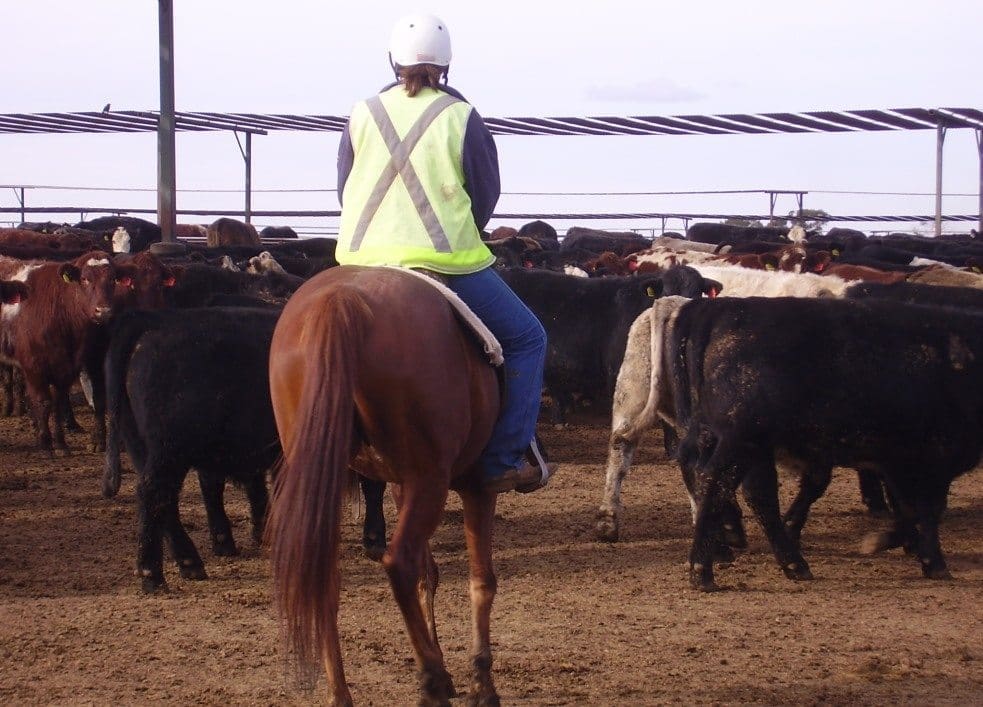Latest listings on Jobs Central recruitment page:
- Assistant Managers (Corfield Downs, Qld)
- Feed Out and Feedmill Operator (Waterfall Feedlot)
- Grader Driver – Wave Hill (Western Grazing)
- Organic Beef Sales & Production Representative (OBE)
- Experienced Meat Trader (Countryfresh)
- Station Manager (Palumpa NT)
- Operations Manager (Adelaide Plains Feedlot)
- Market Analyst – Sheep Value Chain (WA Dept of Ag and Food)
- Feed Out and Feedmill Operator (Waterfall Feedlot)
- Livestock Supervisor (Ladysmith Feedlot)
- General Manager Sales & Marketing (Allied Beef)
Click here to access these and other exciting meat and livestock supply chain jobs currently listed on Jobs Central.

Females now dominate pen riding teams at many larger commercial feedlots, including Prime City near Griffith in NSW.
DESPITE the economic and structural tenacity of Australia’s primary industry sector, there is one particular area that still lingers in the developmental stages – gender diversity.
With a few exceptions, agriculture remains one of the most male-dominated job sectors in Australia, yet to keep up with the contemporary evolution in workforce equality and maintain a competitive market presence, it is essential for agri-businesses to cultivate diversity in their jobs.
So what is the current state of female employees in the red meat industry and what can businesses do to close the divide?
Under-representation of women in industry
According to a 2015 report by the Workplace Gender Equality Agency (WGEA), almost 46 percent of the Australian workforce is made up of women, with just 34.4pc of women making up jobs in the agriculture, forestry and fishing industry.
In addition, there has been almost no change to this under-representation in the last few years.
The 2013 version of the WGEA revealed that 34.9pc of agri-sector workers were women, meaning there has been a decrease of 0.5pc in the period between the two reports.
This demonstrates that the sector needs to do more to shift the imbalance and encourage more women to enter the agricultural sector. Having a greater proportion of female workers on hand can improve the range of expertise and quality of the talent pool.
The advantages of workforce diversity
There are a number of incentives for businesses to pursue gender diversity.
Diversity Australia says that by accessing the widest possible pool of talent, businesses have the opportunity to cultivate a better quality and more sustainable talent pipeline.
Hiring more women can help to make the work environment more engaging and all-inclusive, resulting in greater motivation and improved efficiency.
John Mullen, CEO at Asciano and an ambassador for WGEA, highlights these ongoing benefits.
“Not only do all businesses need to reflect the broader communities in which they operate, but boosting gender diversity immediately deepens the potential talent pool that all businesses rely on to fuel future growth and prosperity,” he said.
Diversity Australia also points out that more variety among workers also cultivates a wider range of skills and abilities, meaning there may be more creativity, as well better problem-solving and decision making.
In the feedlot industry, for example, some yards ‘man’ their pen-riding teams exclusively with women. The reason? Typical responses from yard managers reference attention to detail, observational skills, and ability to focus – all high priorities in the pen-riding role.
Consolidated Pastoral Co is another red meat industry employer which has made progress in this space. Seventy percent of applications for on-property positions with CPC now come from females. The gender ratio among station operational staff at CPC now stands at 60:40 males to females, while at management level (either on-property or in head-office), it is 70:30.
In addition to a reduced cost of employee turnover and better overall performance in the organisation, WGEA says that pursuing equality among gender minimises a company’s legal risk of discrimination and harassment cases, and also improves their public reputation.
Improving the proportion of women in industry
Gender diversity is a pressing matter for today’s society, so how can agri-businesses approach the under-representation?
Talent strategy company Mercer Australia suggest several ways that companies can help correct the gender imbalance, including engaging leadership in the promotion of diversity, proactively helping women manage their careers and making diversity and equality a central company-wide focus.
In order to become a reality, gender diversity needs to be a central value of all businesses, Mercer says.
See this earlier Beef Central article on a similar topic: “Red Meat Processors urged to become more “female friendly”
Source: Meat Processors Pty Ltd
